Tens of species of lizards live in California. A diverse habitat with plenty of food and even protected areas are among the ideal conditions lizards encounter in the state.
Lizards in California grow in coastal areas, at high elevations on mountains as well as in the Southern deserts of the state.
Adapted to a diverse eating habit which includes insects, bugs, and plants, many lizards of the state are active almost throughout the year.
Table of Contents
Are Lizards in California Dangerous?
Almost all species of lizards in California aren’t dangerous. They aren’t venomous and they aren’t particularly known to bite.
A smaller number of species may bite when handled. Lizards using their jaws to capture prey are the most likely to bite.
A rare species known as the Gila Monster may be the only venomous species in the state. However, this species hasn’t been seen for a long time.
Here are some of the most common types of lizards found in California. Most are native while others have an introduced status in the state.
Common Lizards in California
1. Western Fence Lizard

Scientific name: Sceloporus occidentalis
A widespread distribution both along the coast and inland is specific to The Western Fence Lizard. This is a species mostly found in California, with a growing presence in nearby regions of Oregon.
The lizard is found at all elevations up to thousands of feet.
It lives in the state’s chaparral, woodlands, grasslands, and on farms.
This species grows to a maximum length of up to 8 inches. Gray, brown, and green nuances are specific to the lizard.
Common in: along the coast
2. Common Side-blotched Lizard

Scientific name: Uta stansburiana
The Common Side-blotched Lizard is highly common in California and the Southwest.
This is a species that adapts its appearance to its habitat. It can survive without its tail and escape most types of predators.
Common Side-blotched Lizards get their name from the side blotches of males. These types of males are highly aggressive toward each other.
This species can be seen moving around for food in some periods. They are mainly interested in arthropods.
Common in: Southern California
3. Southern Alligator Lizard
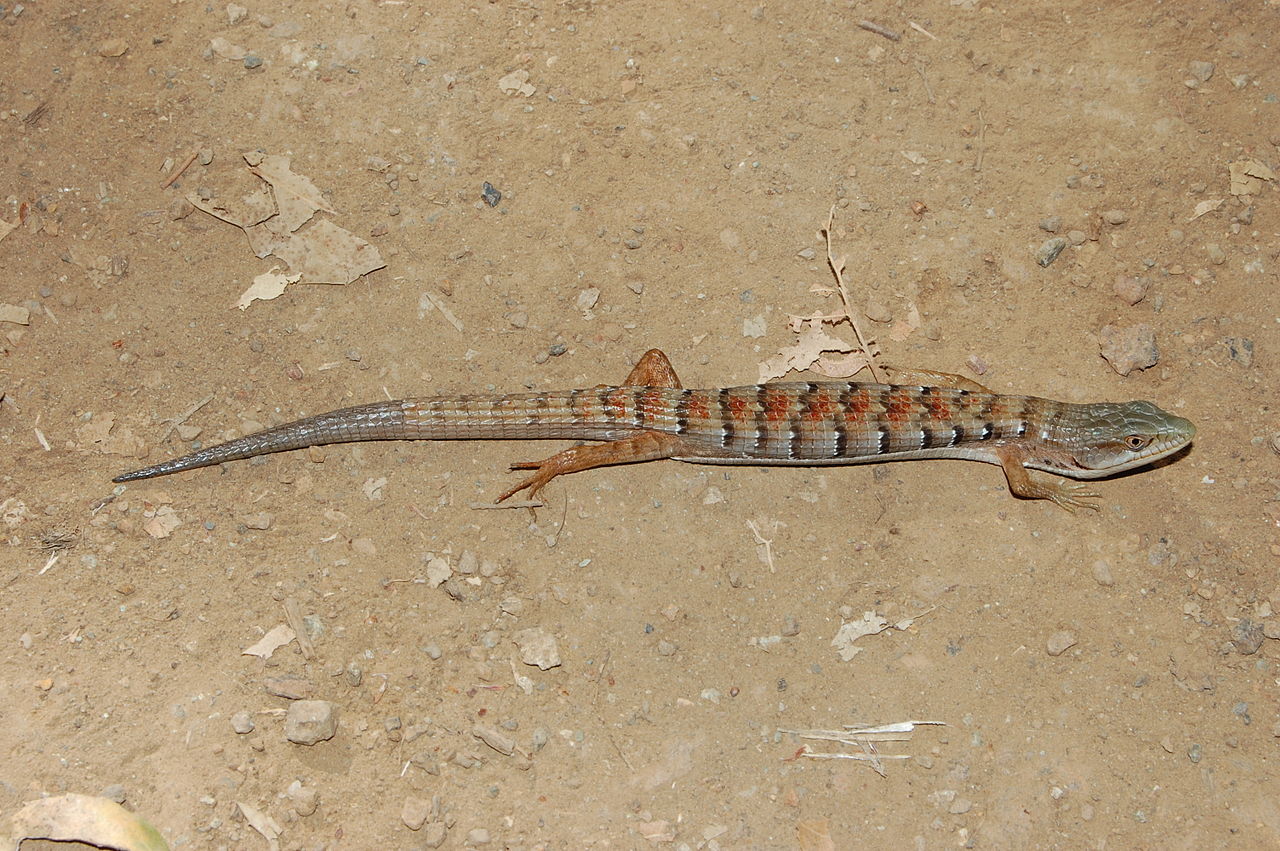
Scientific name: Elgaria multicarinata
Southern Alligator Lizards are found all around California and Baja California.
This common species grows to a size of up to 7 inches, even if most are shorter.
Variable coloring is specific to this species, as with most lizards. It can come in gray and brown colors and it may number around 10 blotches.
Southern Alligator Lizards eat arthropods and other small lizards. This species can also eat venomous spiders in California as their venom does not affect it.
Common in: throughout the state
4. Western Whiptail

Scientific name: Aspidoscelis tigris
The Western Whiptail is highly present in California. This is a species that can live in different areas of the state, with a preference for scarce vegetation and the hot areas in The South.
Although not specific to California, this lizard is found in some specific regions such as chaparral.
Also found along water sources in riparian areas, Western Whiptails have a varied diet. Beetles and grasshoppers are part of their diverse diet.
These lizards are also food for predators such as cats.
Common in: Southern California and chaparral
5. Western Skink
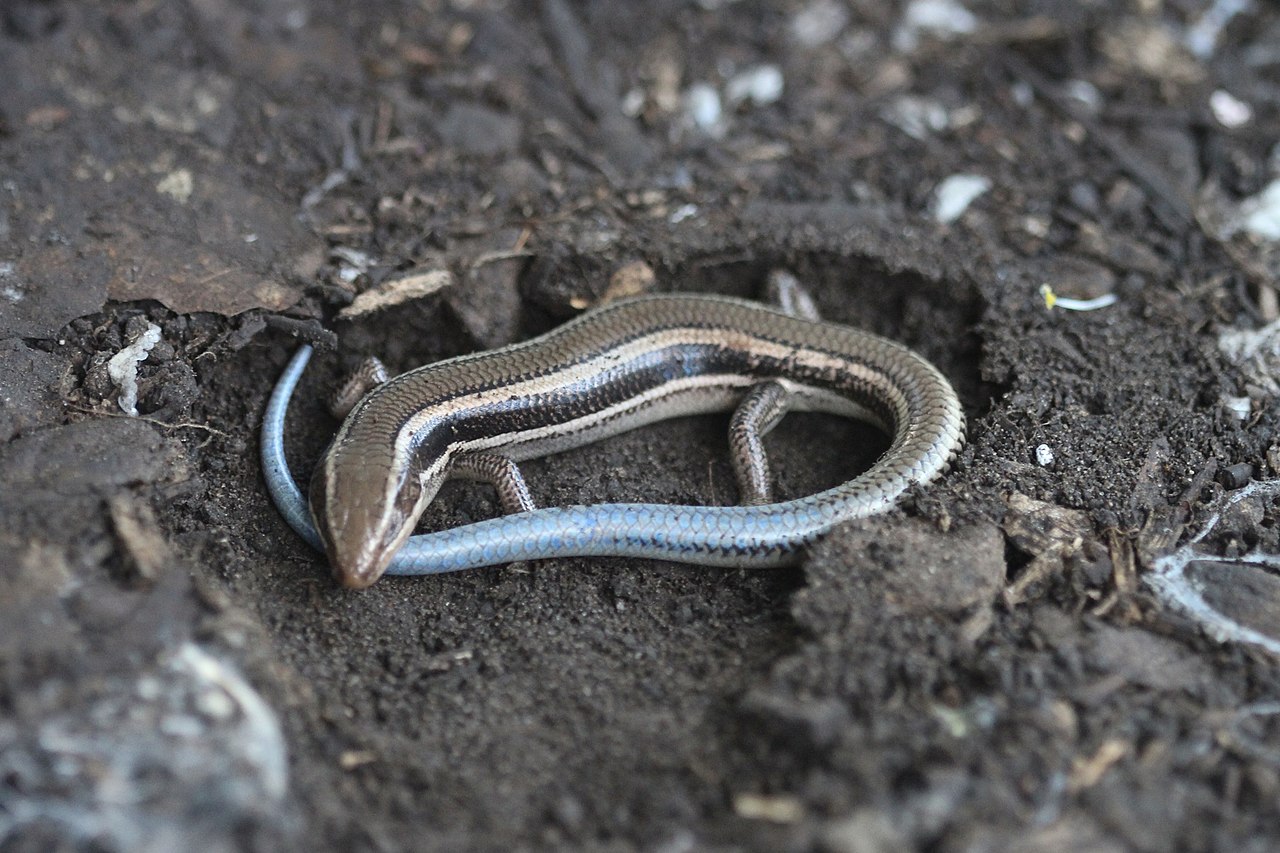
Scientific name: Plestiodon skiltonianus
Western Skinks are among the colorful species of California. This type of lizard changes its colors as it matures.
A striped body with at least 2 brown stripes is specific to the species.
Young Western Skinks are among the few colorful species with a blue tail in the state. The tail of the species eventually takes on the color of its body as they grow.
Found in many areas of the state, including in desert scrub, this species of lizard eats spiders, crickets, and beetles.
Common in: coastal and Northern California
6. Blainville’s Horned Lizard

Scientific name: Phrynosoma blainvillii
Various shades of brown are specific to Blainville’s Horned Lizard. This is a species known for its darker brown shade on its dorsum.
This species also has defensive mechanisms against some of its largest predators. If Western Skinks can play dead, Blaineville’s Horned Lizards can shoot blood. Their blood glands are located next to their eyes.
A species with white lateral spikes, this type of lizard is generally small, barely reaching a length of 4 inches including its tail
Common in: Sacramento Valley
7. Common Sagebrush Lizard
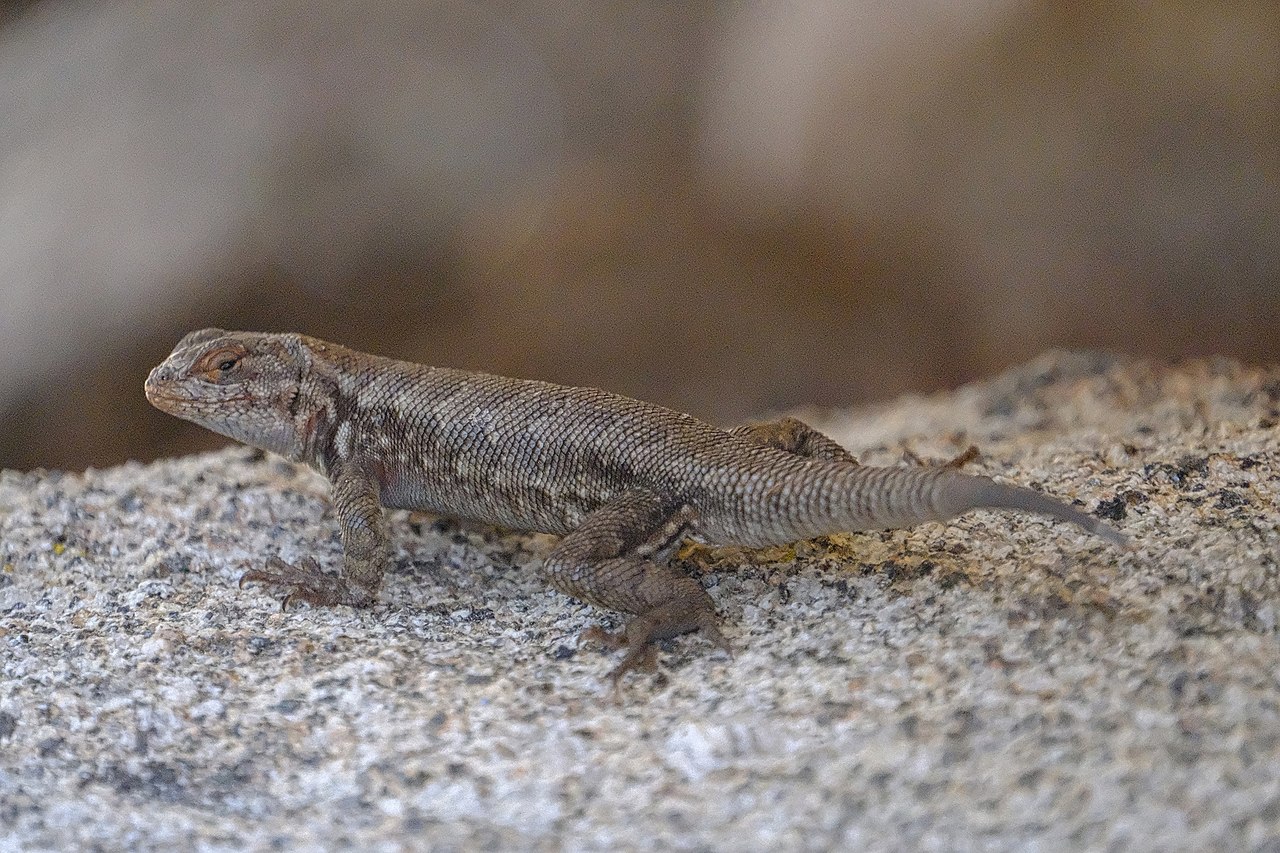
Scientific name: Sceloporus graciosus
Grey and brown colors are the most common on The Common Sagebrush Lizard.
This species is small, measuring around 3 inches. While its range in California is specific to Los Angeles and the South, it may also be seen in an olive color elsewhere.
Common Sagebrush lizards are predated by nocturnal snakes in this region. Birds also hunt for these small lizards.
Ants, flies, and bugs such as beetles are part of the Common Sagebrush Lizard’s diet.
Common in: Southern California
8. Northern Alligator Lizard

Scientific name: Elgaria coerulea
Brown, green, and yellow-brown are among the typical colors of The Northern Alligator Lizard.
The species is larger than the average lizard in California. Some of the largest Northern Alligator Lizards grow to a size of 11 inches.
The large size of the species allows it to eat larger prey. Some of the larger prey it eats include a small mic.
This type of lizard also eats slugs and moths.
Its adaptability to different types of terrains opens up its dietary preferences. Northern Alligator Lizards can be found at sea level and altitudes of thousands of feet.
Common in: Northern California
9. Granite Spiny Lizard

Scientific name: Sceloporus orcutti
This type of lizard comes in gray, green, yellow, or even blue color combinations.
The central dorsal area coloring is what typically separates the look of the male from the female. A few small blue scales are seen on the male while females tend to have yellow nuances.
Southern parts of California are among the ideal habitats for the species. This lizard is even found around large urban areas such as San Diego.
Granite Spiny Lizards get their name from their preference for rocky terrains.
Common in: Southern California and Baja California
10. Common Chuckwalla

Scientific name: Sauromalus ater
Common Chuckwalla lizards often stray to California from Sonora. They have a growing range along the state’s Eastern border.
This type of lizard is known for its wide body of light brown color.
Common Chuckwalla is part of a smaller group of primarily herbivorous lizards in California.
This species eats different wildflowers such as greasewood. They may only consider eating insects when easily accessible on this wildflower or when they cannot find suitable plants to eat.
Common in: Southeastern California
11. Desert Iguana
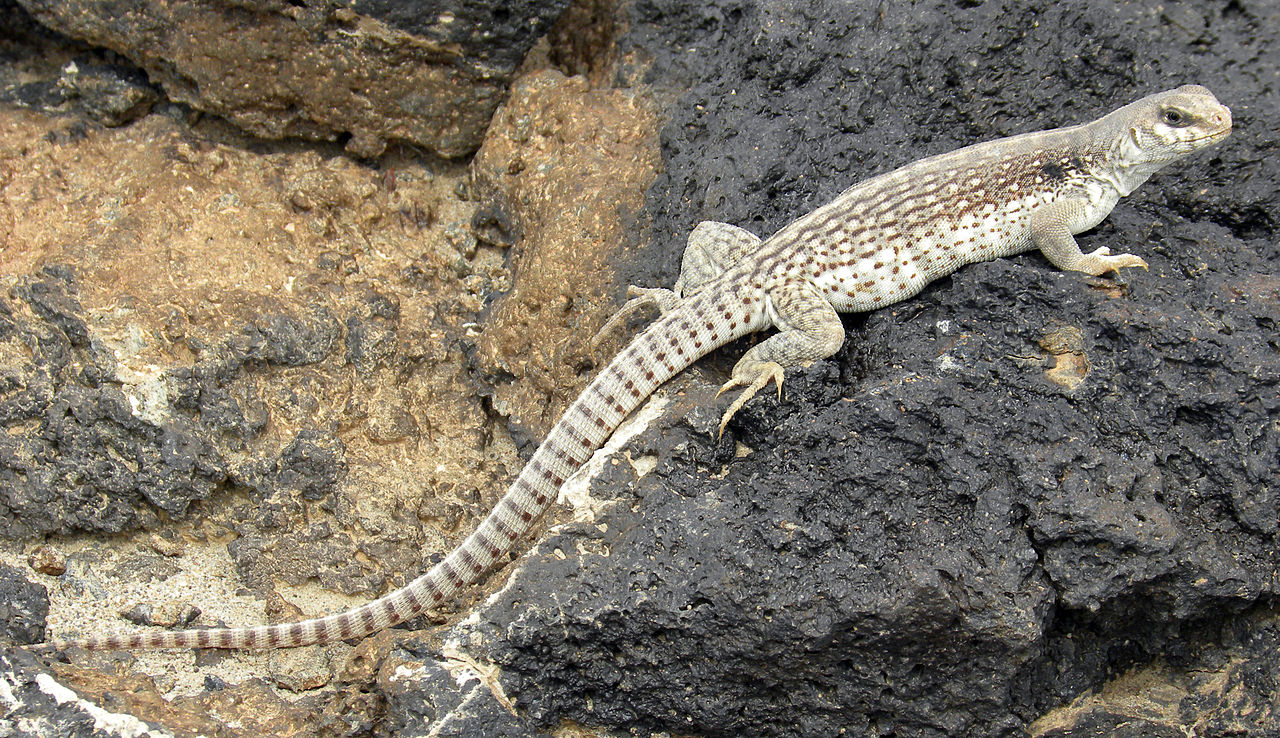
Scientific name: Dipsosaurus dorsalis
A pale combination of colors is seen with Desert Iguanas. Their preference for desert and arid regions influences their gray or brown colors to a pale nuance.
This type of lizard is among the largest in California. It may reach a total length of up to 16 inches.
As Common Chuckwallas, Desert Iguanas are also primarily herbivorous, with a high interest in creosote bush.
These types of lizards are burrowers. They are often only interested in burrowing right next to the bushes they eat, such as greasewood.
Outside of California, Desert Iguanas can also live in subtropical woodlands.
Common in: Southeastern areas
12. Zebra-tailed Lizard

Scientific name: Callisaurus draconoides
A light brown color is specific to the Zebra-tailed Lizard. The species has a white and black tail which inspires its name.
A pure white ventral color is specific to the Zebra-tailed Lizard, except for its tail.
Zebra-tailed Lizards are small to medium-sized. They grow to a size between 2 and 4 inches.
Moths and insects are among the typical prey of this small-sized lizard.
Zebra-tailed Lizards can be seen burrowing in the sand, mainly to lay eggs.
Common in: Mojave Desert
13. Desert Horned Lizard

Scientific name: Phrynosoma platyrhinos
A tan color is specific to this type of desert lizard. Most of its body, legs, and tail are covered in a tan color or a light brown color.
The dorsum of the species is decorated with darker bands. These bands can be dark brown or black, depending on their habitat.
Pointy spines cover the entire body of the lizard, including the legs. Its spines can also have a tan color or they can be white, in the case of the lateral spines.
Ants and ladybugs are among the most common prey for the species.
Common in: Southeastern California
14. Orange-throated Whiptail

Scientific name: Aspidoscelis hyperythrus
A striped body and jerking leg movements help identify Orange-throated Whiptails.
These types of native California lizards go through considerable color changes as they grow.
Juvenile lizards have blue tails and blue legs, being easily spotted in their natural habitat. Their legs and tails eventually become gray and black, as they mature.
A striped body is specific to the adult Orange-throated Whiptail. As their name suggests, the males of this species have an orange underside or orange throat region, even if this is not specific to all males.
Common in: Southern California
15. Desert Spiny Lizard
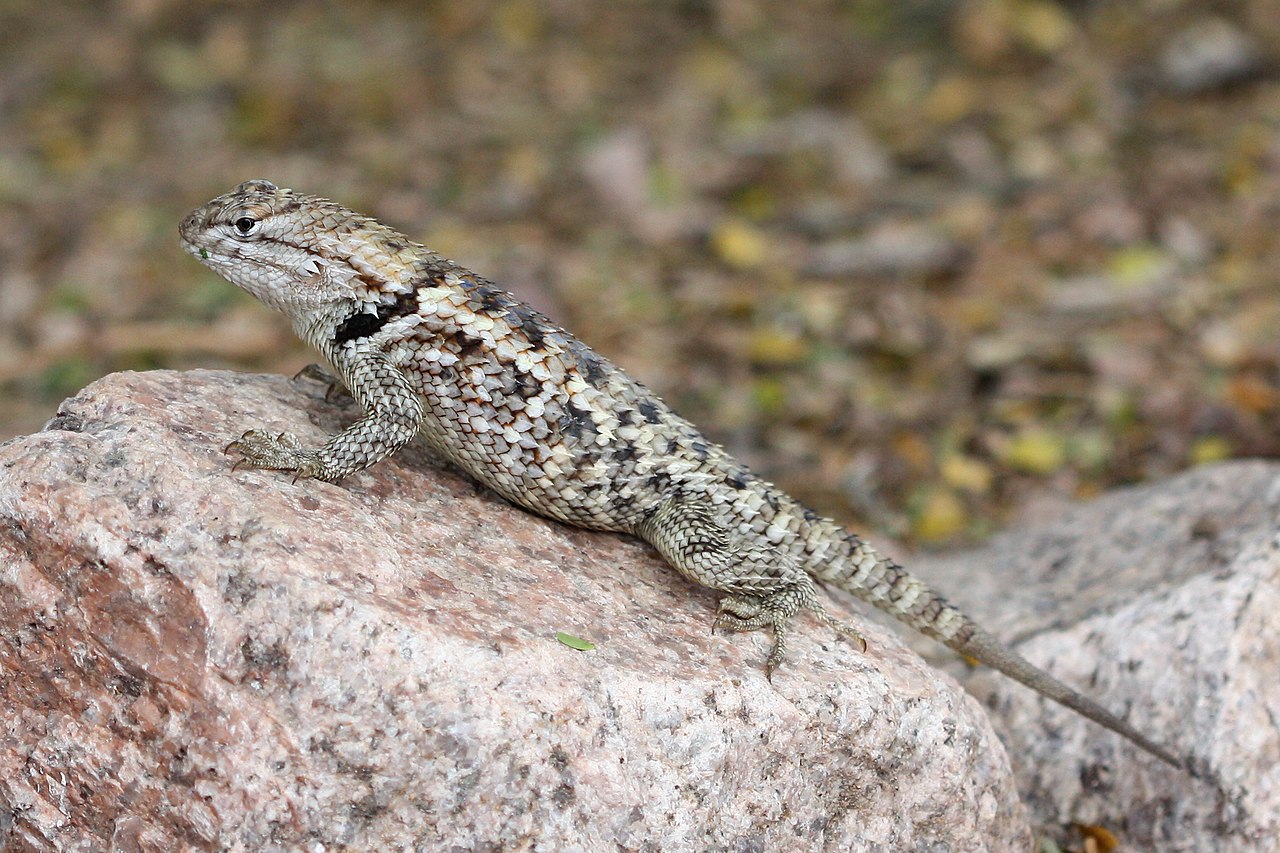
Scientific name: Sceloporus magister
This species of desert lizard is known for its colorful spiny body. The spines cover its body, head, legs, and tail.
Color variations are seen between males and females.
The male Desert Spiny Lizard may show green sides and tails. They can also show blue sides and tails. Females and juveniles lack this color.
Males with blue ventral coloring only have blue bellies while the lower side of the tail remains white.
Caterpillars and beetles are on the long list of dietary preferences of Desert Spiny Lizards.
Common in: Southern California
16. Western Banded Gecko

Scientific name: Coleonyx variegatus
Western Banded Geckos are a common species in California’s Southeast. This is a species with a banded appearance.
Yellow and pink-sand coloring is specific to Western Banded Geckos, a species that grows to 4 inches.
The species grows to a size between 2.5 and 4 inches with a preference for shrub-known areas of deserts.
These geckos play an important role in the ecosystem as they feed on spiders and even young scorpions in Southern California.
Common in: Mojave and Sonoran Deserts
17. Yellow-backed Spiny Lizard

Scientific name: Sceloporus uniformis
A base brown color with yellow dorsal sections is specific to The Yellow-backed Spiny Lizard.
This type of lizard may come in a yellow-dominant dorsum color, with black bands and a red-brown section behind the head.
Large than females, the male Yellow-backed Spiny Lizard may reach a maximum 5.5-inch length.
This type of lizard spends most times of the day hiding underground.
The diet of the species is based on bugs, ants, and other small insects.
Common in: Mojave Desert
18. Long-nosed Leopard Lizard

Scientific name: Gambelia wislizenii
A large range of colors and color combinations are specific to the Long-nosed Leopard Lizard. This species can come with a spotted body, which inspires its name.
Most nuances of the species are bright. Gray and brown bright nuances are often paired with brown spots and orange spots across its body.
A longer tail than the body is also specific to The Long-nosed Leopard Lizard.
Eating insects and small rodents, this type of lizard is also typical prey to other species in the state.
Snakes and birds are among the typical predators of the lizard.
Common in: Southeastern California
19. Green Anole

Scientific name: Anolis carolinensis
The Green Anole is one of California’s lizards that can change colors, even if not a true chameleon.
It can change colors from green to brown and grow to a size of up to 8 inches. Popular in captivity, this species has escaped into the wild, mainly around San Diego for decades.
The species eats bugs such as grasshoppers and is also a typical prey food for various local predators.
Cats are among the typical predators of the species, especially around cities and gardens.
Green Anoles are known to be highly aggressive and territorial.
Common in: San Diego County
20. Gilbert’s Skink

Scientific name: Plestiodon gilberti
Gilbert’s Skink grows to a size of up to 4.5 inches. The appearance of this species depends more on age than on gender.
Adults show a type of uniform coloring, unspecific to juveniles. The adult Gilbert’s Skink can be brown or gray, with occasional olive sightings.
Juveniles show a more complex coloring pattern that also includes bands.
While this species is also found in nearby states, its distribution mainly includes California.
The adaptable species can live both in the desert areas of the state and at higher elevations in pine-rich areas.
Common in: San Joaquin Valley and Southern California
21. Flat-tailed Horned Lizard

Scientific name: Phrynosoma mcallii
The Flat-tailed Horned Lizard is one of the first lizards to be documented in California. It only lives in the Southeastern range of the state and it is known as a fat or flattened lizard.
This type of body shape is not the result of overeating but rather the result of complex camouflaging evolution.
By having a wider underbelly, this species limits or even eliminates the shadows of its own body on the ground.
This makes it almost impossible to spot its predators, given it takes on the sandy colors of its habitat.
A reduced habitat of the species in North America list this species as protected.
Common in: Sonoran Desert
22. Mediterranean House Gecko

Scientific name: Hemidactylus turcicus
This spotted lizard has been introduced to North America from Europe. It’s believed plant transports introduced it to The United States.
The species is well established in Texas and Florida, but it also has a growing presence in California.
A bright body with brown spots is specific to this species, sometimes also referred to as The Turkish Lizard.
Controlling the species may be difficult as it resists pesticides.
This type of lizard can be found around homes as they hunt insects flying around lights at night.
Common in: Riverside County
23. San Diegan Legless Lizard
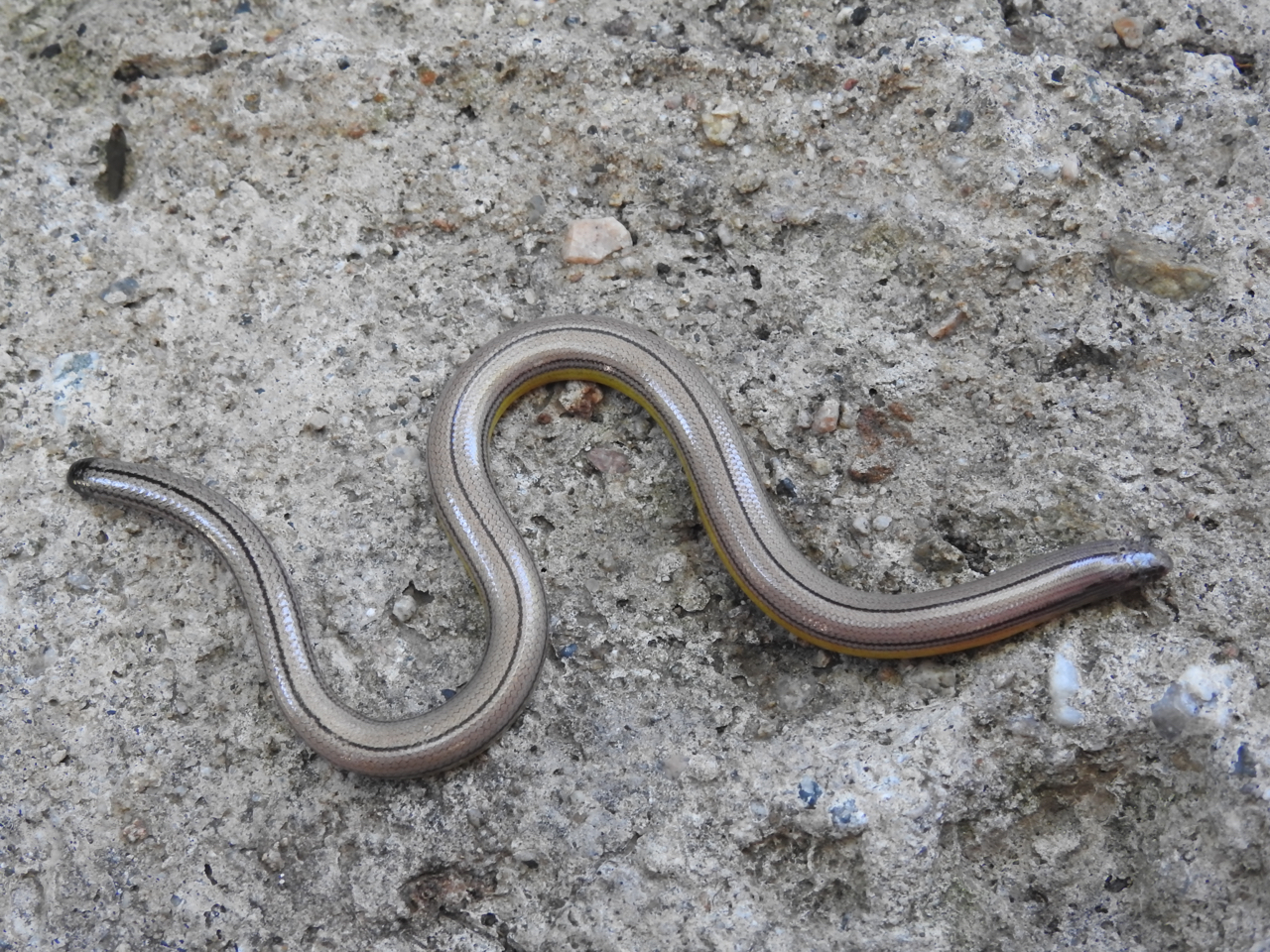
Scientific name: Anniella stebbinsi
A distinct legless body is specific to this type of lizard around San Diego. Similar to earthworms from above, The San Diegan Legless Lizard has an olive color.
It also comes in olive-gray and brown variants.
Its legless body is believed to be an adaptation to its sandy habitat.
The San Diegan Legless Lizard spends much of its life underground, burrowing in the sand on beaches.
Excessive urbanization has led to a threatened and protected status of the species in the Southern parts of the state.
Common in: San Diego to Los Angeles
24. Banded Rock Lizard

Scientific name: Petrosaurus mearnsi
This type of lizard is mainly seen on rocks and in rocky areas. It looks for different types of crawling insects to eat such as those of the spider family.
Native to North America, The Banded Rocky Lizard has gray, olive, or brown colors. It may also show faint blue spots.
The species stands out with a banded tail, once it reaches adulthood. A gray and black tail is specific to the species.
Banded Rocky Lizards are slightly smaller than other species. They may grow to a maximum size of 2-3 inches.
Common in: Southern California
25. Desert Night Lizard

Scientific name: Xantusia vigilis
This type of lizard is diurnal, despite its name.
Found in some of the aridest conditions in the state, this species survives deserts by choosing locations with at least some vegetation.
These are the places where it can find ants and other insects to feed on and where it can also rest and burrow.
The Desert Night Lizard is often spotted in areas with Joshua Trees.
Lizards of this species remain active into the evening. They are known for changing to a lighter color in the evening and a darker color during the day.
The lizard may reach a maximum length of around 4 inches.
Common in: Southern California
26. Desert Collared Lizard

Scientific name: Crotaphytus bicinctores
The Desert Collared Lizard is a species found almost all around California, except in the coastal areas.
A multicolored body is specific to the species. Brown-to-orange coloring is specific to its body and its legs. Its head and tail are mostly gray with brown spots and smaller brown areas.
White spots are also specific to this species which is known to grow to a size between 3 and 5 inches.
Common in: Eastern California
27. Italian Wall Lizard
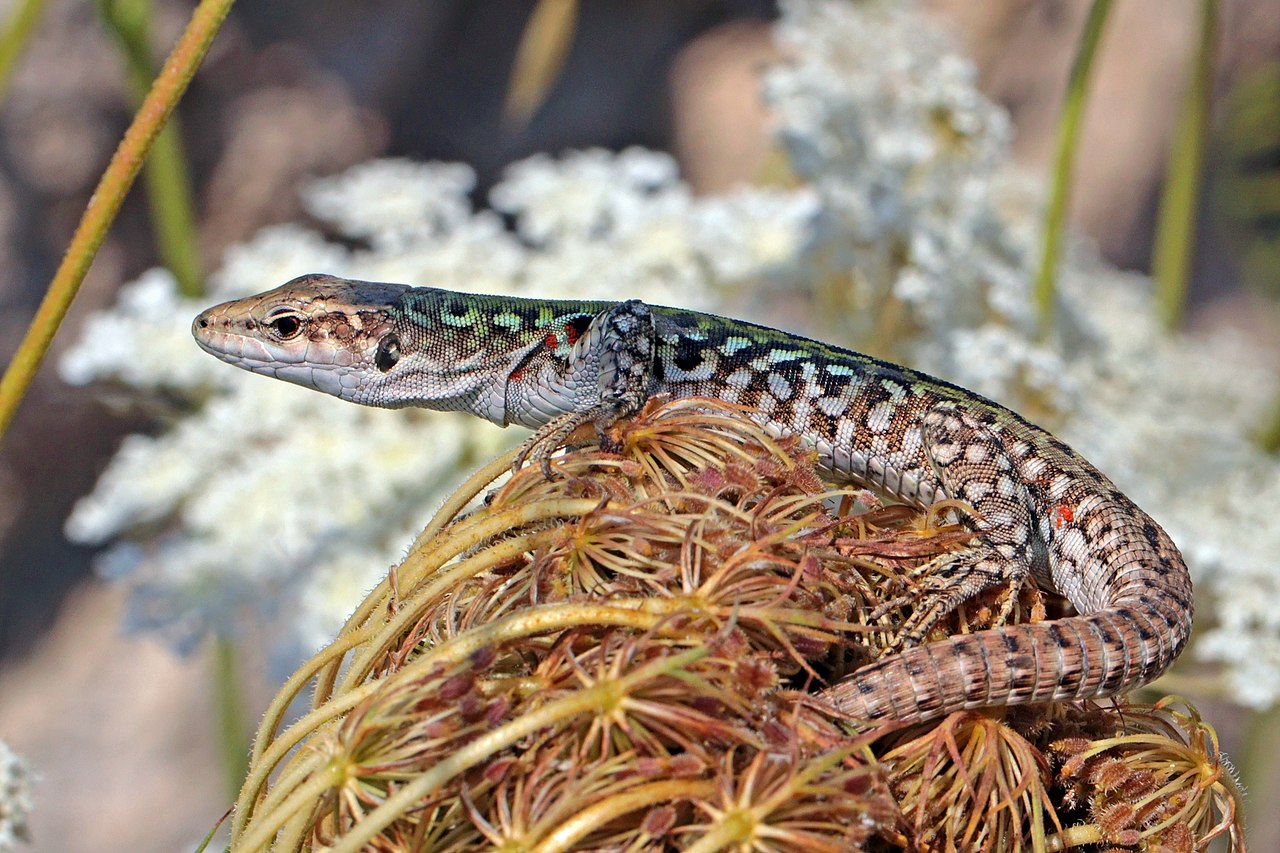
Scientific name: Podarcis siculus
A typical dorsal green color is seen on most types of Italian Wall Lizards while the rest of their body is light brown.
Dark brown spots border its mid-dorsal green area. One of the exceptions of this look comes with Blue Italian Wall Lizards.
As its name implies, this species originates in Italy and it has spread to Europe and North America.
It has established itself without impacting local lizards and it can sometimes be spotted eating beetles.
Common in: Southern California and Baja California
28. Mojave Fringe-toed Lizard

Scientific name: Uma scoparia
The Mojave Fringe-toed Lizard is one of the few species in California that eats scorpions. It also eats spiders and other types of insects.
This species has a contrasting appearance. Its light gray, brown, or yellow base color is contrasted by dark brown spots along the body and sometimes the tail.
With the capacity to camouflage itself and to burrow, the species may only be spotted when looking for food and when not hibernating as the species is inactive until February.
Common in: Mojave Desert
29. Granite Night Lizard
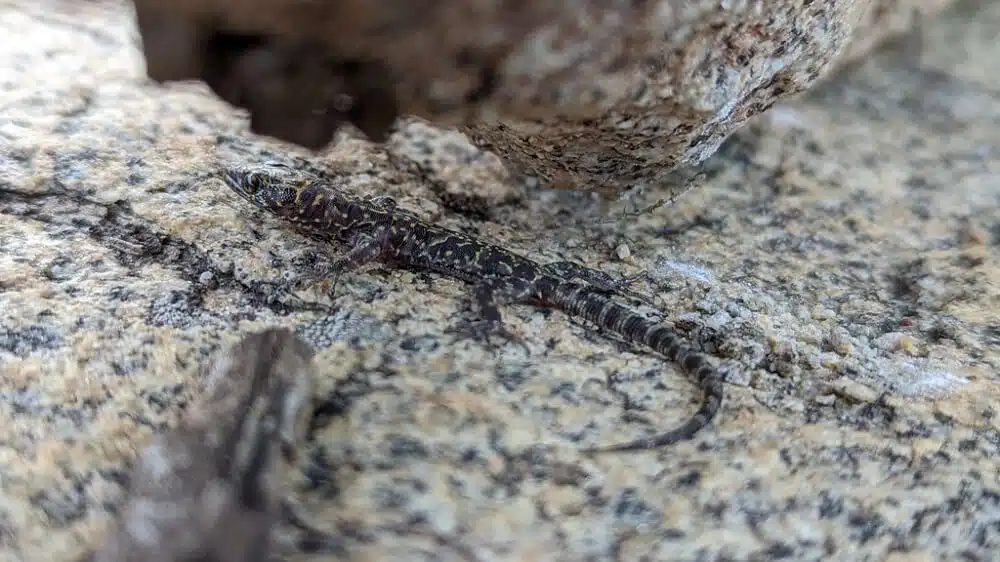
Scientific name: Xantusia henshawi
Active both during the day and the night, Granite Night Lizards may only be spotted around large boulders.
They prefer a shaded place in various crevices during the day and possibly a more active lifestyle during the night when they exit crevices.
Large brown blotches are seen on its bright body. This is one of the lizards which shows large spots on its head, body, and tail of a similar size and nuance.
Most lizards of this species can be found in the Southern limits of the state with occasional sightings in coastal habitats.
Common in: Southern California
30. Long-tailed Brush Lizard

Scientific name: Urosaurus graciosus
A very long tail inspires the name of this species. The tail of the Long-tailed Brush Lizard is around twice as long as its body.
Together with its tail, this species can grow to a length of up to 6.7 inches.
Gray base color with faint brown dorsal stripes is characteristic of this type of lizard.
The species is arboreal and its coloring helps it hide in plain sight.
An omnivorous species, this type of lizard eats flies and insects but it can also eat various plants.
Common in: the Sonoran Desert and Baja California
31. Coachella Valley Fringe-toed Lizard

Scientific name: Uma inornata
Once a threatened species, Coachella Valley Fringe-toed Lizard remains one of the rare species in California outside of its range.
The species has a bright gray body with dark grey spots along its head, dorsum, and tail.
Living in desert areas but not in coastal areas, this is a species that can spend much of its time buried in the sand.
It has adapted to breathing below the surface which means it can spend a long time in the sand.
Common in: Coachella Valley National Wildlife Reserve
32. Northern Legless Lizard
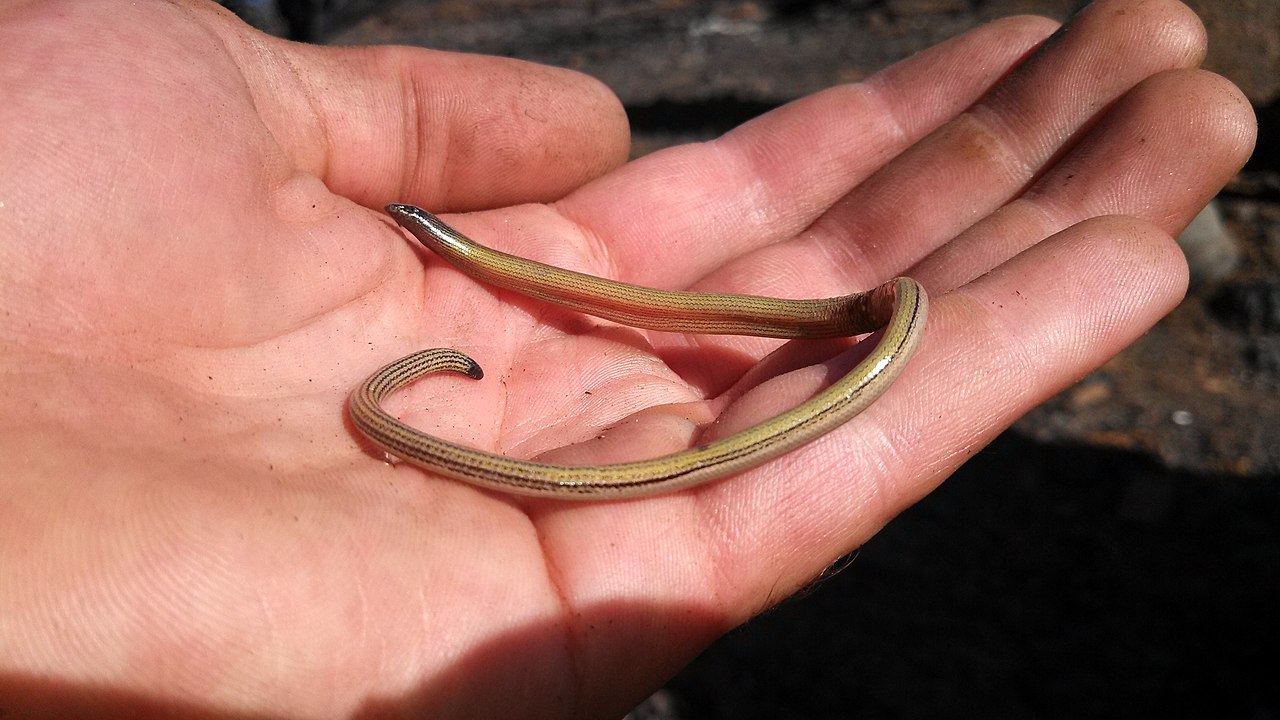
Scientific name: Anniella pulchra
A species of lizards without legs, the Northern Legless Lizard may be confused with young snakes or earthworms.
This species has varying colors. Its most common color is silver on the dorsal side and yellow ventral coloring.
A brown morph also exists.
A long lizard despite not having legs, The Northern Legless Lizard grows to 7 inches. It feeds on small beetles and small insects.
Common in: Southwestern California
33. Island Night Lizard

Scientific name: Xantusia riversiana
A wide variety of colors and color combinations is specific to this lizard which may reach a length of around 7 inches.
It comes in brown and gray uniform colors but also spotted forms. Black and white spots and stripes are also common in the species.
According to its habitat, the species may adapt to a different color combination.
Island Night Lizards are found in sandy areas along the coast where they can be spotted in the fall when females give birth to live young.
Common in: Coastal areas
34. Brown Anole

Scientific name: Anolis sagrei
Brown Anoles are present in Southern California and other regions of The US such as Hawaii.
As one of the common lizards of the area, the species is seen in different colors and patterns even across California.
It ranges from shades of brown to shades of gray. A common dark brown morph with cream spots is a typical look in Southern California.
This species may grow to a maximum length of 8 inches but is only seen together when mating.
Male Brown Anoles can show high aggression levels toward other males.
Common in: Southern California
35. Colorado Desert Fringe-toed Lizard

Scientific name: Uma notata
Much of the appearance of this lizard is influenced by The Colorado Desert. A sandy gray base color is seen on the lizard.
Black and orange spots are seen across its dorsum.
A type of native lizard, this is the only species in the desert and Baja California to show small orange dorsal spots which helps with correct species identification.
Common in: Colorado Desert
36. Blunt-nosed Leopard Lizard
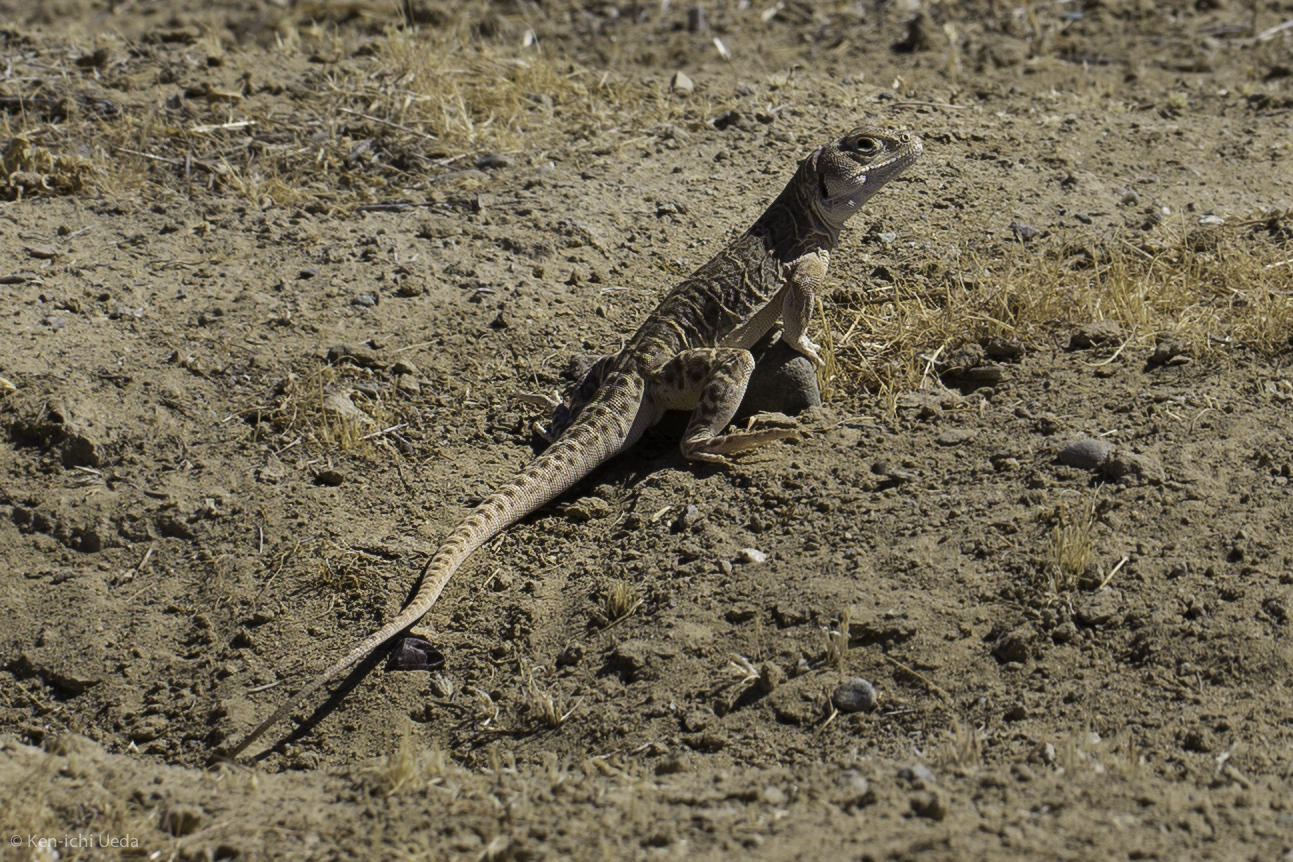
Scientific name: Gambelia sila
One of the endangered species of California, Blunt-nosed Leopard Lizards get their name from their leopard-like appearance.
A bright gray or tan color is the uniform color base of the species. Dark brown spots are seen across its dorsum which inspires the name of the species.
This is one of the endangered species of the state which may eat other lizards.
However, the bulk of its diet is represented by insect beetles.
This species is now endangered in the state either due to fragmentation or the complete disappearance of its natural habitat.
Excessive cattle feeding on some of the vegetation it lives around reduces its habitat.
Common in: San Joaquin Valley
37. Peninsular Leaf-toed Gecko

Scientific name: Phyllodactylus nocticolus
This species lives in a small range in Southern California but abundantly. It lives far from urban areas which allow it to thrive in desert scrub and rocky areas.
A nocturnal species, The Peninsular Leaf-toed Gecko spends most of its day in crevices, coming out at night.
A bright gray color is specific to this species, similar to the color of the boulders it lives around.
Brown spots and marks are further distinguishable on its dorsum.
Its tail has a more uniform dark gray color and contrasts its brighter body and legs.
Common in: Anza-Borrego Desert State Park, Riverside County
38. Baja California Collared Lizard
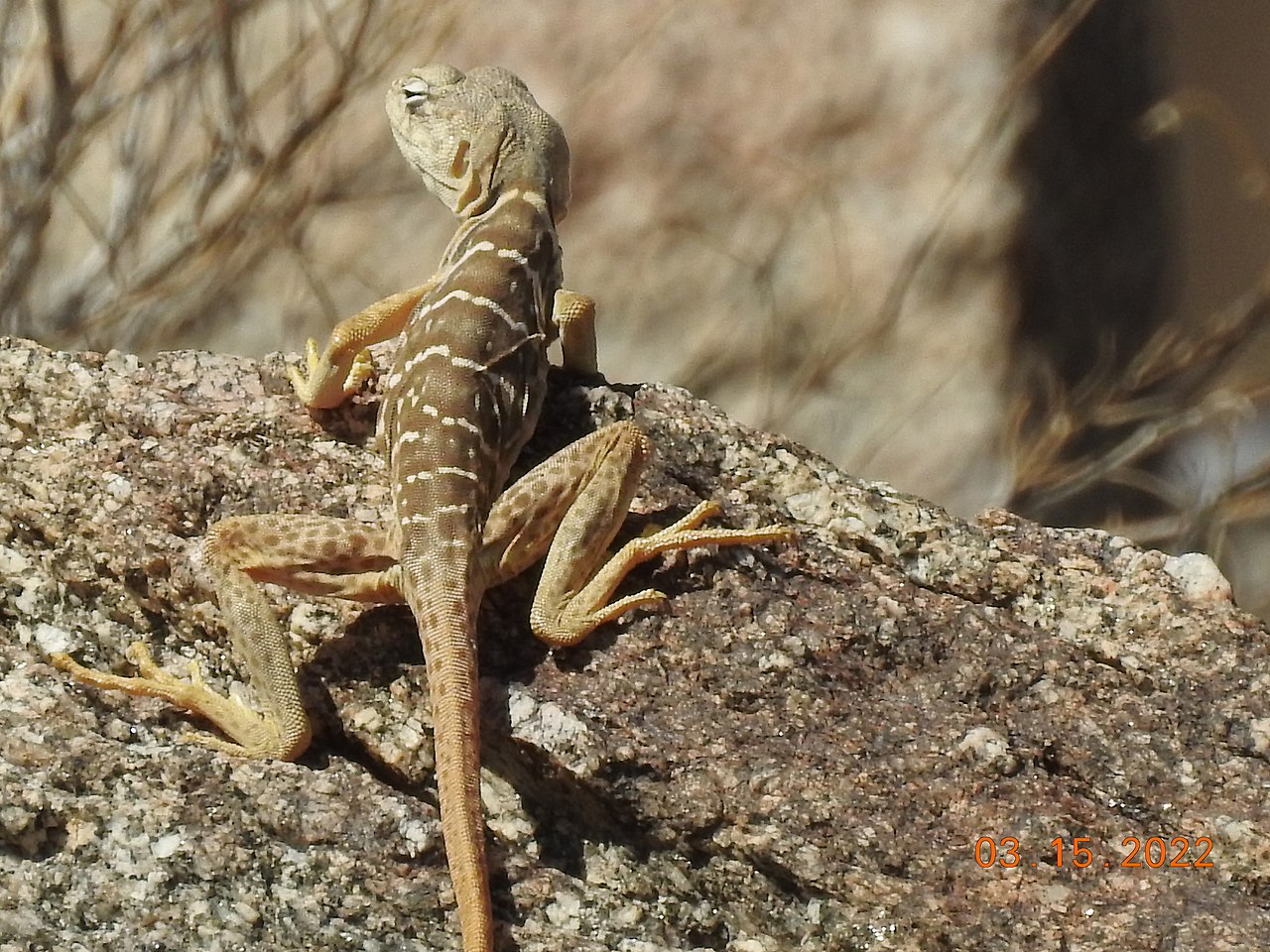
Scientific name: Crotaphytus vestigium
Various shades of brown and a white-banded body is specific to this type of Southern lizard.
It comes with white marks and dots as well as brighter limbs.
The species can run on 2 legs, which makes it distinct from other lizards in the state. It enjoys stable numbers since it lives in a protected area.
This type of lizard also has vivid colors on its ventral side which aren’t always visible. Males of the species may have blue ventral coloring.
Common in: Southern California and Baja California
39. Sonoran Spotted Whiptail

Scientific name: Aspidoscelis sonorae
Brown and green contrasting coloring is specific to The Sonoran Spotted Whiptail.
This species has dark brown dorsal stripes with tan spots along its body.
Its ventral color has a distinct light green or lime green color.
A typical predator of termites, this type of lizard is present in smaller numbers in California compared to its nearby states.
It eats different types of arthropods as well as termites and beetles.
Common in: San Diego County
40. Moorish Gecko

Scientific name: Tarentola mauritanica
This type of gecko has a European origin and a growing presence across the state.
It features variable coloring and patterns with a body that measures up to 6 inches.
A bright yellow color with white marks is specific to this species. The gray and dark gray coloring is also specific to the gecko that lives in sandy habitats such as around the Southern deserts.
This species may be a vector of diseases to other species. It is known for carrying gecko mites.
Geckos of this species are sometimes spotted on the walls of homes next to lights, where they can find various insects to feed on.
Common in: San Diego County
41. Black-tailed Brush Lizard

Scientific name: Urosaurus nigricauda
This type of arboreal lizard is found in different types of trees and vegetation in the Southern parts of the state.
Much of this species’ description is based on various shades of gray. A light gray color covers its body while dark gray or black spots contrast its dorsal area.
Black-tailed Brush Lizards don’t have actual black tails, but darker tails. This species is also known for having a tail at least twice as long as its body.
While not endangered, The Black-tailed Brush Lizard is only present in small numbers in California.
Common in: Southern California, Baja California
42. Ornate Tree Lizard

Scientific name: Urosaurus ornatus
Ornate Tree lizards have often been compared to small alligators based on their multicolored bodies.
A dark brown dorsal color is specific to the species, followed by light brown and tan nuances. The Ornate Tree Lizard has a black dorsal pattern visible on males.
These types of lizards are common almost all year except December.
They eat different ants, termites, and flies but their diet changes with the seasons.
Lizards of this species may also consider eating plants when they are in season. Vegetables across the state are also eaten by the lizard.
Male Ornate Tree Lizards are arboreal species known to fight other males through high levels of aggression.
Male lizards of the species have also been shown to increase their testosterone production in the face of potential predators.
Common in: Southeastern California
43. Indo-Pacific House Gecko

Scientific name: Hemidactylus garnotii
An introduced species in California, Indo-Pacific House Geckos are growing in numbers along the Southern and Southwestern areas of the state.
Growing to a size of up to 5.5 inches, this introduced lizard comes in different colors.
Bright brown color with tan spots is specific to The Indo-Pacific House Gecko.
The species is also seen in a dark green color with dark brown to black dorsal marks.
White or yellow ventral coloring is specific to the species.
Young Indo-Pacific House Geckos may also exhibit orange tails or orange ventral tail coloring.
Common in: San Diego County
44. Tropical House Gecko

Scientific name: Hemidactylus mabouia
A length of up to 5.5 inches including the tail is specific to The Tropical House Gecko.
This species is known for eating a wide range of bugs and isopods. These are among the typical types of lizards in the state which may be beneficial to humans by eating cockroaches.
Mostly found around urban areas and small municipalities, The Tropical House Gecko is a species that can make loud sounds.
Sometimes believed to be poisonous, this lizard Is generally harmless to humans.
Common in: Southern California
45. Flat-tailed House Gecko

Scientific name: Hemidactylus platyurus
Flat-tailed House Geckos are arboreal species with good climbing abilities. Their wide toe pads allow them to climb different types of vertical surfaces.
This species is known to come in different colors and even change colors throughout the day.
It can appear pink at noon and become darker in the evening.
Yellow-orange, gray and brown, or light brown and dark brown are colors and color combinations this type of lizard can also be seen in.
Common in: Southern California
46. Cope’s Leopard Lizard

Scientific name: Gambelia copeii
Different habitats such as coastal scrub are among the ideal areas for the species in California.
Also found in woodlands, this type of lizard comes in different colors, often including at least a small red area along the body.
Gray to dark brown coloring is specific to this species. Its tail is typically darker gray with bright gray bands.
The species shows distinct bright red bands across the body as well as around the head in the case of the females.
These red color patches indicate the female is gravid.
Common in: San Diego County
47. Sandstone Night Lizard
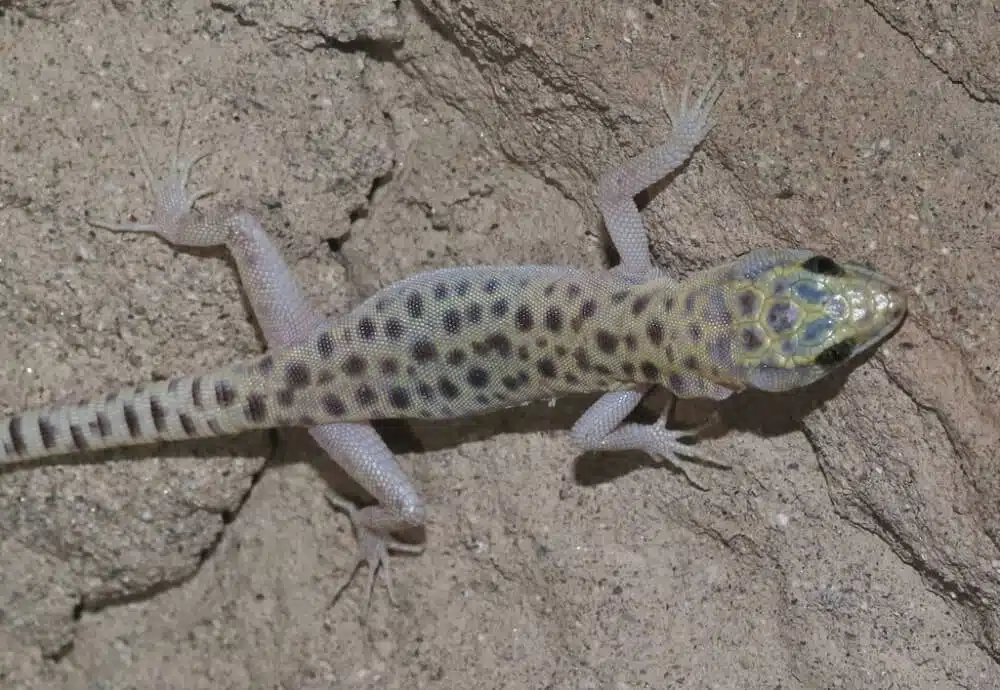
Scientific name: Xantusia gracilis
This type of lizard has only been correctly identified as an individual species for a few years.
It is one of the most secretive types of lizards in Southern California which makes research on the species limited.
Found along desert roads, this type of nocturnal lizard hides in burrows.
It has a sand-gray color with either black or dark brown dorsal spots. These dark spots are further identifiable on its tail.
Common in: Colorado Desert, San Diego County
48. Baja California Night Lizard
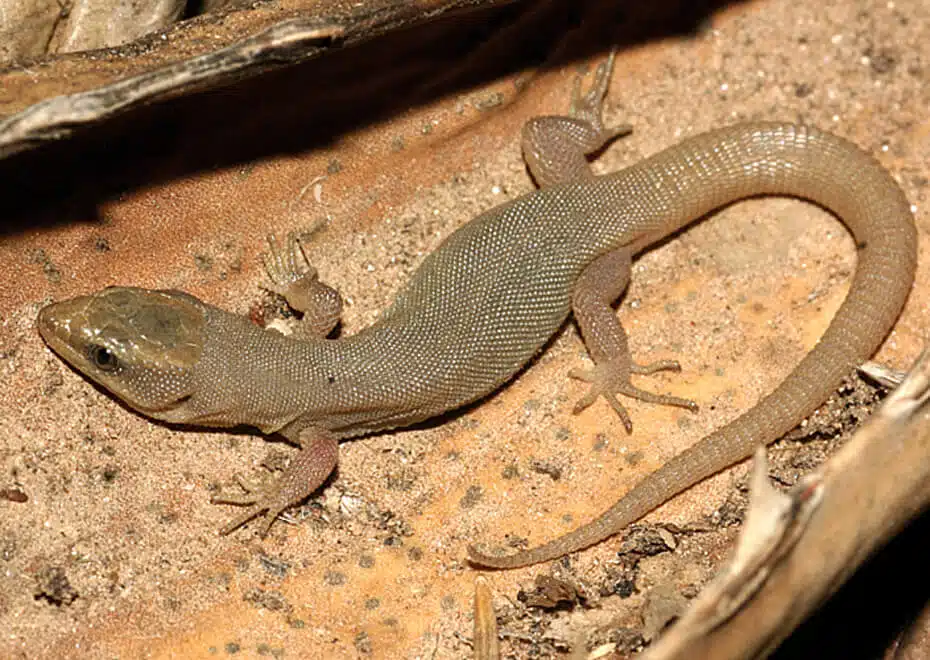
Scientific name: Xantusia wigginsi
This type of lizard has a sedentary lifestyle and comes in a wide range of colors.
Its appearance varies from a striped body to a uniform coloring.
Some of the rarest morphs of the species are those of green nuances.
Most Baja California Night Lizards are gray or brown. They may exhibit yellow patterns dorsally but many lizards have uniform dark brown coloring.
Common in: Southern California and Baja California
49. Barefoot Banded Gecko
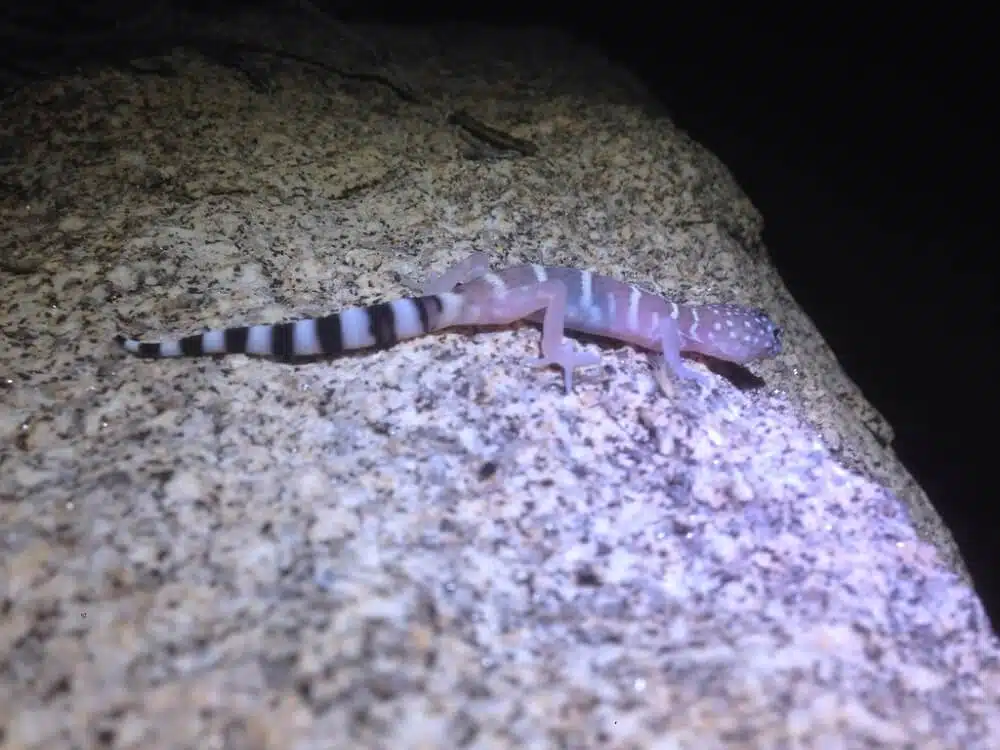
Scientific name: Coleonyx switaki
A native species in Mexico, Barefoot Banded Geckos have expanded their habitats to California.
This species lives in sandy areas around deserts. It also lives in rock crevices in California’s deserts.
Some of the most distinctive traits of the species include a banded black and white tail. The lizard can come in a green body or a light brown body color with or without black or white patterns.
Common in: Southern California, Baja California
50. African Five-lined Skink

Scientific name: Trachylepis quinquetaeniata
African Five-lined Skinks are among the rare types of lizards in the state. They may grow to a maximum length of 8 inches.
An African native, the lizard is now introduced across various US states such as California and Florida.
This species can be identified by its olive, brown, or gray color.
African Five-lined Skink lizards are also known for having blue tails. The bright blue tail of the species tends to stand out regardless of its habitat.
Found in grasslands and the rocky Southern California habitats, this species can climb trees and it is known for eating ants and butterflies.
Common in: San Diego County